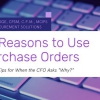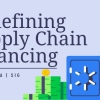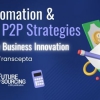The Top 3 ERP Transformations that Support Buyers
B2B companies are currently up to their necks in “digital transformation.” They're moving at a rapid clip to enhance the customer experience through technologies that automate processes while focusing on marketing, sales, and e-commerce. While this was percolating before COVID-19, it’s now all-encompassing and tied into the overall business strategies. On the back end, ERP providers and their VARs are scrambling to keep up. Maybe, just maybe, it’s time to take a step back and look at this through a different lens.
Recently, software providers such as Infor and SAP, along with industry leaders like MDM and NAW, have all published white papers or held forums on the “what” and “when” of digital transformation elements. Strategy, roadmap, commitment and continual investment are the keys to staying ahead of the curve. What we have not heard is, “How are my customers going to fund these projects” or “Which project has the most immediate financial impacts to my business.” But the most important question is which project has the lightest internal lift, is the easiest to deliver and doesn't require change management to drive adoption from internal customers.
As the brain and central nervous system for a business, ERP systems are very complex and can be challenging to maintain, especially older legacy systems. Most ERP solutions and resellers create additional revenue streams by providing customers with value-added technology, integrations and professional services. That’s especially true right now when new systems are increasingly harder to sell.
From the buyer perspective, implementing a new ERP is like open-heart surgery. Similarly, new technology projects are feared as a drain on internal resources, and who wants to part with cash in uncertain times? The risk appears too great in the current market climate, while the need to upgrade, enhance and automate is paramount. In short, they want an attractive, simplified facelift of functionality to the ERP that improves their agility in virtually serving customers.
The focus is primarily on the external customer and often neglects areas within their customers’ business where change is not perceived as immediately necessary.
Supporting their customers’ digital transformation efforts has stretched many ERP companies too thin for them to take on major integrations. If their professional services organizations aren’t already tapped out by working on e-commerce, they're doing projects such as CPQ (configure, price, quote), mobile order entry or other customer-facing applications.
Partnerships are a proven strategy for obtaining solutions without having to buy and build them internally. By partnering with industry-leading businesses with a back-end operational focus, ERP providers can offer add-ons that complement their newly digitized front-end processes, deliver them more rapidly and to a democratized customer base. With that in mind, here are three relatively easy back-office automation plays that ERP providers should consider right now.
Order Management Automation
Automating order management is a no brainer in the “order-to-cash process.” As businesses build eComm into their revenue organizations, they still need to accommodate all customers and their preferred transacting business methods.
While expanding online order acceptance, any manual processes will consume resources and present error risks for businesses that grandfather in older processes like accepting orders via fax. That said, the result is a smooth and versatile system that speeds up back-office processes without causing undue strain on internal teams.
Accounts Receivable Automation
Accounts receivable automation pairs well with e-commerce upgrades. Customers may already accept payments online. However, for those who still need to invoice, accounts receivable automation can support efficient workflow creation. Such a move could improve cashflow and shorten DSO (days sales outstanding).
However, it may require them to rethink how they submit invoices to their customers: via EDI, paper, PDFs or CD-ROMs, which (believe it or not) are still in use. AR automation requires standardizing and automating invoice transmission. That could require some change management and internal resources on the part of the ERP provider, working in conjunction with the technology provider to get customers set up.
Payment Automation
All businesses are already making payments to suppliers, maybe some of them through an ERP module, but there's still likely significant manual work involved. Best-of-breed payment automation solutions take four payment modes—check, ACH, card and wire—and put them into one streamlined interface. When using this type of system, the buyer decides which invoices they want to pay and they don't even need to keep track of how each supplier wants to be paid. The payment service provider handles all the supplier enablement, and the software intelligently directs funds to approved suppliers in their preferred method.
The concept of payment automation adoption is now over a decade old. In that time, payment automation providers have perfected the implementation process only to take a few weeks and minimal internal effort to get started. That means it can happen concurrently with front-end projects. The time and money saved (and potential rebates earned) by utilizing such a system enables businesses to allocate excess funds for other transformation projects.
Overall, digital transformation acceleration is a positive thing for ERP providers and partners. Their customers, who are in an “innovate or die” situation, are open to more outside-the-box solutions than before and are leaning on their ERP providers as a result. They have the opportunity to make a mark on their customer’s future success and garner recognition for their work.
At the same time, they have to adopt innovation themselves. Every day, one ERP or another is coming out with a new module or integration. The day of the monolithic tech stack is gone. Customers want to pick and choose what works best for their business. To retain their customers, ERP providers have to connect to as many different solutions as possible.
Right now, the back office is the best focus for improvements. Partner up and offer connected solutions, like automated order management, accounts receivable and payments. If you’re looking for a place to start, I recommend automating payments first. That type of scenario creates a win-win situation because you create another revenue stream right out of the gate, and your customers generate a profit from something that used to be a drag on their bottom line. The revenue saved or generated from that initiative can pay forward into other automation options, creating a simplified system that pays your efforts forward.









